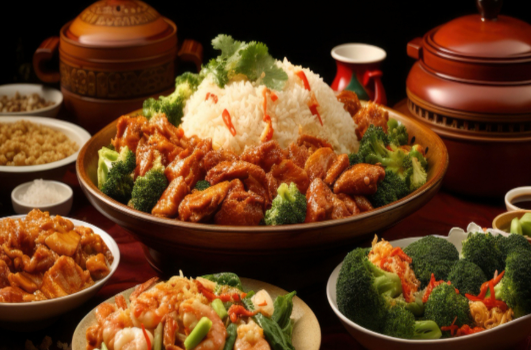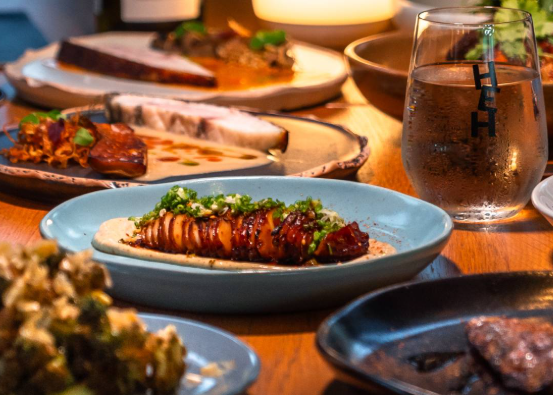
Malaysia is a food paradise, where you can taste the perfect blend of Malay, Chinese, and Indian influences. With a rich history of diverse cultures, the local food scene reflects this unique mix. If you’re planning a trip to this vibrant country, make sure to explore these essential dishes and experiences that define Malaysian cuisine.
Nasi Campur
A classic dish you’ll find at food courts across Malaysia, Nasi Campur (which means “mixed rice”) is a must-try. It consists of a plate of rice with a variety of pre-cooked dishes and sides you can pick from a buffet-style setup. Each region offers its own twist on Nasi Campur, with Nasi Kandar (Indian-inspired) popular in the north and Nasi Padang (Malay and Indonesian-inspired) favored in the south. This is an easy and inexpensive way to get a taste of the country’s culinary variety.
Fish Head Curry
Fish Head Curry is a bold and spicy dish that has earned its place as one of Malaysia’s iconic offerings. While it’s believed to have originated in Singapore, this dish is a staple in Malaysia as well, especially at Nasi Kandar restaurants. Made with red snapper’s head, vegetables, and a rich South Indian-style curry, it’s a flavorful, fiery treat. This dish is the result of an Indian chef’s attempt to cater to Chinese tastes, making it a unique fusion of cultures.
Beef Rendang
Though originally from Indonesia, Beef Rendang is a beloved dish in Malaysia. The beef is slow-cooked in coconut milk and a spice paste made of ginger, turmeric, and chilies. The long cooking process ensures the beef becomes tender and the sauce thickens into a rich, caramelized perfection. Rendang is a staple at Nasi Campur buffets, and it’s the kind of dish that shows the depth of Malaysian culinary techniques.
Nasi Lemak
Nasi Lemak is often regarded as Malaysia’s national dish. It’s a simple yet flavorful meal that consists of coconut milk-infused rice, crispy fried anchovies, peanuts, and a spicy sambal sauce. This dish is traditionally eaten for breakfast but can be found all day long. Served wrapped in banana leaves, it’s especially delicious when paired with fried or grilled chicken, making it a satisfying meal any time.
Char Kway Teow
Char Kway Teow, often compared to Thailand’s Pad Thai, is a stir-fried noodle dish made with flat rice noodles, eggs, prawns, and bean sprouts. Stir-fried in soy sauce, this dish is simple but packed with flavor. It’s a common dish across Malaysia and can be found in street food stalls and restaurants. The ingredients may vary regionally, with some places adding cockles or fish cakes to the mix.
Mee Goreng
Mee Goreng is a fried noodle dish often served in food courts and hawker stalls throughout Malaysia. While similar to Char Kway Teow, it uses egg noodles instead of flat rice noodles. Mee Goreng can be made with various proteins, including chicken, beef, or prawns, and is typically stir-fried with vegetables and chili paste. It’s a quick, filling meal, but not as exciting as other dishes on this list.
Curry Mee
Curry Mee is a spicy noodle soup made with egg noodles and a coconut-based curry broth. This dish includes fried tofu and beansprouts, with the option of adding congealed blood cubes for extra texture. It’s similar to the Thai dish Khao Soi but with a more Indian-inspired flavor profile. Curry Mee is widely available and is a favorite among curry lovers.
Chicken Satay
Satay is a beloved barbecue dish in Malaysia, featuring marinated pieces of chicken skewered and grilled over open flames. It’s served with a peanut sauce that can vary in spiciness depending on the region. The best versions of Satay often come from Indonesia, but Malaysia puts its own spin on the dish, especially with chicken wings as an increasingly popular variation.
Loh Mee
Loh Mee is a Penang specialty made with thick egg noodles in a gooey, egg-based broth. This dish is complemented by crispy pork pieces, fried pork skin, and crunchy beansprouts, and often topped with a boiled egg. Loh Mee is a great choice if you’re in Penang, as it’s one of the area’s most beloved noodle dishes.
Hokkien Mee
Originating from the Chinese Hokkien province, Hokkien Mee is a stir-fried noodle dish that’s particularly popular in Kuala Lumpur. The noodles are stir-fried with pork lard, pork, prawns, and dark soy sauce, creating a rich and flavorful dish. It’s typically served with lime, chili, and sambal for extra kick.
Wonton Mee
Wonton Mee is a Chinese-inspired dish that consists of egg noodles served with dumplings filled with ground pork and shrimp. The noodles are often cooked in soy sauce and accompanied by Chinese broccoli. Wonton Mee is a favorite at many food stalls and can be served in soup or as a dry dish with soup on the side.
Butter Prawns
Butter Prawns is a modern Malaysian dish that blends Chinese, Malay, and Indian cooking techniques. The prawns are cooked in a rich sauce made with butter, egg, coconut milk, and curry leaves, resulting in a creamy, spicy dish. There are two variations: the wet version, with a saucy consistency, and the dry version, which is covered in crispy egg floss.
Claypot Chicken Rice
Claypot Chicken Rice is a comforting dish that’s cooked and served in a traditional clay pot. The rice is slow-cooked with stock and chicken, creating a crispy bottom layer and a smoky flavor. This simple yet delicious dish is a great choice for those looking for a warm, satisfying meal.
Biryani Rice
Biryani is a fragrant rice dish that’s popular in Malaysia’s Mamak restaurants. The rice is cooked with spices like cardamom and chili powder, and layered with yogurt for extra flavor. Often served with mutton curry or tandoori chicken, Biryani is a hearty meal that’s perfect for a special occasion.
Roti Canai
Roti Canai is a popular flatbread that originated in India but is now a staple in Malaysia. It’s a simple, pan-fried bread that’s served with curry sauce or various meat curries. Variations like Murtabak (stuffed Roti) and Kotthu (Roti mixed with meat and egg) add exciting twists to this humble dish.
Tandoori Chicken
Tandoori Chicken is a dish that’s made in a traditional clay oven called a tandoor. The chicken is marinated overnight in a mixture of spices and yogurt, then grilled in the tandoor to achieve a perfectly tender interior and crispy exterior. It’s a must-try for anyone visiting Malaysia.
Samosas
Samosas are deep-fried pastries filled with spiced potatoes, meat, or vegetables. These tasty snacks are commonly found in Indian-influenced areas of Malaysia, especially in food courts or at curry puff stands. They make for a quick and satisfying snack, perfect for eating on the go.
Steamboat Hot Pots
Steamboat, or Hot Pot, is a communal dining experience that was introduced by Chinese traders in Malaysia. Guests cook their own meats, vegetables, and noodles in a simmering broth, choosing from a variety of flavorful options like Malay Soto, Thai Tom Yum, or spicy Sichuan. It’s a fun, interactive way to enjoy a meal with friends.
Lok Lok Hot Pot
Lok Lok is a street food variation of Hot Pot, where skewered meats and vegetables are dunked into a hot broth for a quick cook. It’s a fast, casual way to enjoy the flavors of Hot Pot and is often served with a variety of spicy dips and sauces.
Rojak
Rojak is a fruit and vegetable salad tossed in a sweet, sour, and spicy chili and tamarind dressing. The fruits used vary by season and region, but common ingredients include water apple, pineapple, and mango. A similar dish, Pasembur, is an Indian-inspired version with deep-fried vegetables and a sweet, spicy sauce.
Ais Kacang
Ais Kacang is Malaysia’s version of a shaved ice dessert. It’s a refreshing treat made with layers of shaved ice, fruits, beans, and syrups. It’s a popular choice for a cool, sweet finish to a meal and can be found at food courts and dessert stands throughout the country.
Durian
Durian is Malaysia’s famous “King of Fruits,” known for its strong smell and divisive taste. Some people love its creamy, sweet flesh, while others find it overpowering. Durian is typically available from June to October, and trying it is a quintessential Malaysian experience.
Extra Strong Beer
In Malaysia, alcohol is heavily taxed, but you can still find strong beers with high alcohol content. The local Carlsberg Special Brew is 8.8% ABV, but many beers, including Guinness, have higher alcohol content here compared to other countries. If you’re a fan of strong drinks, this is something to explore.
Fruit Juices and Teh Tarik
For those avoiding alcohol, Malaysia’s fresh fruit juices are an excellent alternative. Lychee juice and salted mango lassi are my personal favorites. Teh Tarik, a frothy tea made with black tea and condensed milk, is another daily staple in Malaysia. It’s often enjoyed at Mamak restaurants alongside meals.
Malaysian cuisine offers an incredible variety of dishes influenced by a diverse cultural landscape. Whether you’re savoring a rich beef rendang or cooling down with Ais Kacang, the food here is a reflection of the country’s vibrant and delicious heritage.








